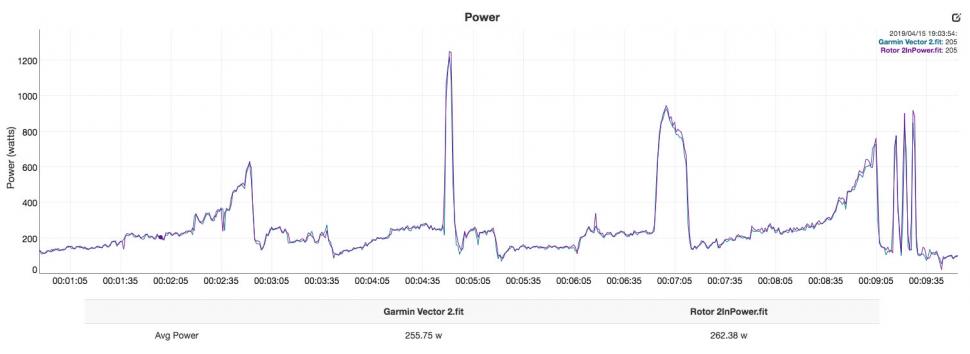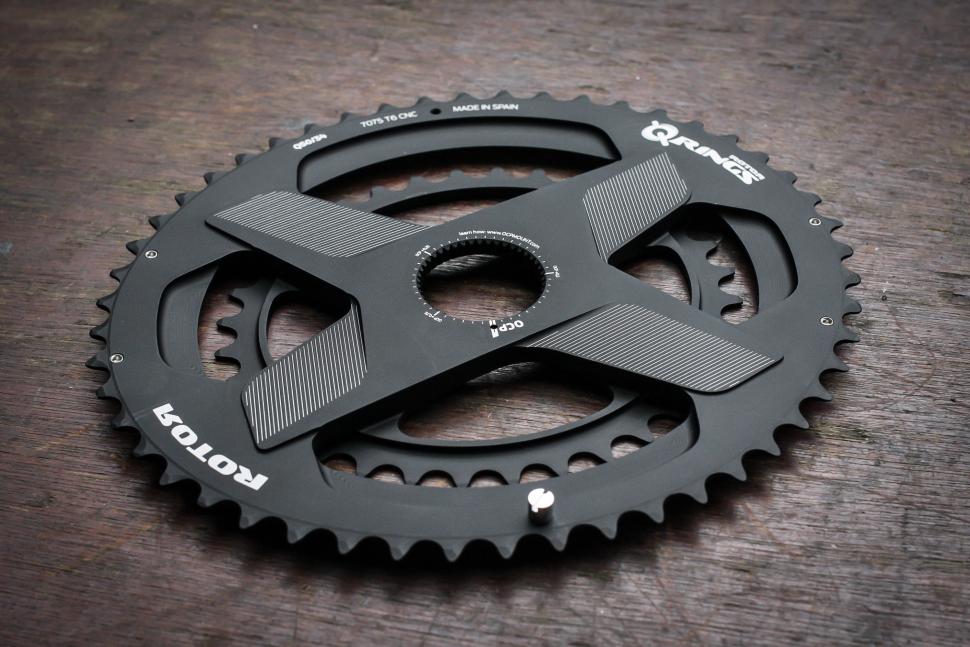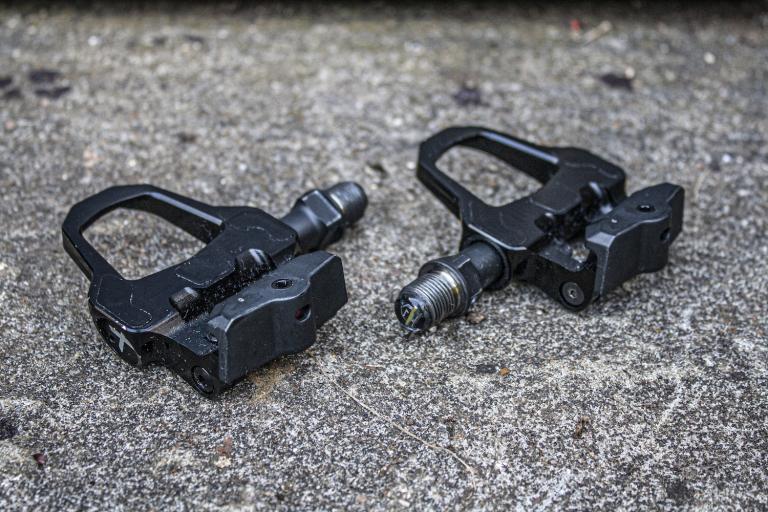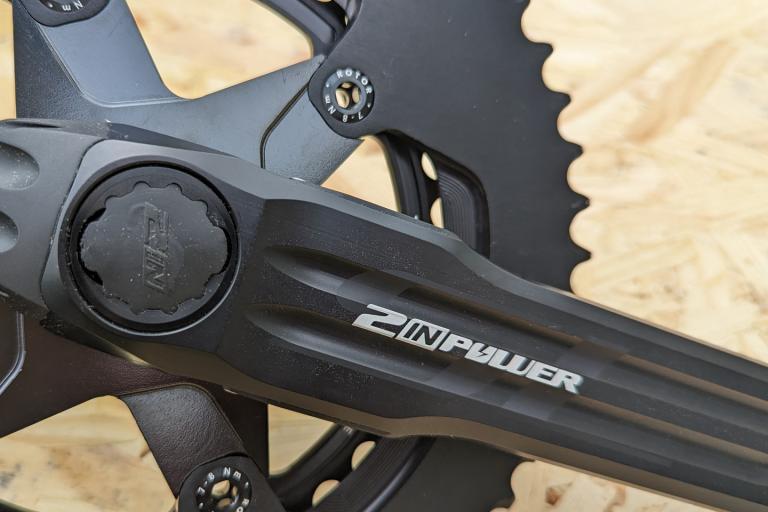- News
- Reviews
- Bikes
- Components
- Bar tape & grips
- Bottom brackets
- Brake & gear cables
- Brake & STI levers
- Brake pads & spares
- Brakes
- Cassettes & freewheels
- Chains
- Chainsets & chainrings
- Derailleurs - front
- Derailleurs - rear
- Forks
- Gear levers & shifters
- Groupsets
- Handlebars & extensions
- Headsets
- Hubs
- Inner tubes
- Pedals
- Quick releases & skewers
- Saddles
- Seatposts
- Stems
- Wheels
- Tyres
- Tubeless valves
- Accessories
- Accessories - misc
- Computer mounts
- Bags
- Bar ends
- Bike bags & cases
- Bottle cages
- Bottles
- Cameras
- Car racks
- Child seats
- Computers
- Glasses
- GPS units
- Helmets
- Lights - front
- Lights - rear
- Lights - sets
- Locks
- Mirrors
- Mudguards
- Racks
- Pumps & CO2 inflators
- Puncture kits
- Reflectives
- Smart watches
- Stands and racks
- Trailers
- Clothing
- Health, fitness and nutrition
- Tools and workshop
- Miscellaneous
- Buyers Guides
- Features
- Forum
- Recommends
- Podcast
£1,300.00
VERDICT:
Good quality crank-based power meter with lots of chainring options and plenty of data on tap
Weight:
798g
Contact:
At road.cc every product is thoroughly tested for as long as it takes to get a proper insight into how well it works. Our reviewers are experienced cyclists that we trust to be objective. While we strive to ensure that opinions expressed are backed up by facts, reviews are by their nature an informed opinion, not a definitive verdict. We don't intentionally try to break anything (except locks) but we do try to look for weak points in any design. The overall score is not just an average of the other scores: it reflects both a product's function and value – with value determined by how a product compares with items of similar spec, quality, and price.
What the road.cc scores meanGood scores are more common than bad, because fortunately good products are more common than bad.
- Exceptional
- Excellent
- Very Good
- Good
- Quite good
- Average
- Not so good
- Poor
- Bad
- Appalling
If you're looking for a fit and forget power-measuring option for a single bike then a crank-based system is a good choice: you can swap wheels and pedals without affecting your measurements. The Rotor 2InPower DM Road system is certainly one to look at: it's nicely made, the power numbers are credible and repeatable, and you get the option of oval or round rings on an easy-to-swap direct mount interface.
- Pros: Repeatable power measurement, lots of chainring options
- Cons: Difficult to move between bikes, benefits of oval rings not really measurable
The 2InPower cranks weigh in at 609g, and the rings (50/34 oval direct mount) were 189g. That's a total of 798g, which is about 85g heavier than the Shimano 105 chainset the system replaced. It's reasonably easy to fit and compatible with BB30, pressfit30, BBright, BB386evo, BB86 and ITA/BSA threaded bottom brackets; it doesn't come with a BB so you'll need to factor that in too.
> Find your nearest dealer here
Crank-based systems are really only an option if you have a specific bike you want to measure power on, they're not interchangeable like a wheel or pedals would be.
Charging up the cranks is easy enough: you get a proprietary magnetic lead which attaches to the centre of the drive-side crank. I'm not normally a fan of proprietary leads but it makes sense here and allows the unit to be fully sealed. The rubber cover on the contacts swings out of the way but it's easy to knock off and lose if you're not careful.
If you're running oval rings – Rotor offers both oval and round rings in direct mount – then you have the option of a number of different positions on the spider to correspond to your physiology. You won't know which position is best for you until you've got everything set up and running (more on that in a bit), so in the first instance it's best to go for the middle position. A lockring holds the ring in place and the whole system is very neat, with the rings very nicely machined.
I was using a one-piece spider and chainring assembly; that means you'll be replacing the whole thing if either of the chainrings wears out; on the plus side it's an easy job, and you can even try a single ring setup if you like. There's a separate spider and chainring setup available if you habitually wear out one ring before the other.
Both the Rotor 3D cranks and the direct mount chainring feel nice and stiff, with no chain rub on the front mech even on hard sprint efforts.
Once the cranks are set up on your bike you just need to pair them with a thing. The 2InPower cranks transmit on both Bluetooth and ANT+; Rotor has its own app for smartphones, and they'll work with pretty much any GPS head unit or indoor training environment.
> Six reasons why you should use a power meter
The most important thing you want to know about a power meter is: are the power readings on point? So without further ado, let's delve into some graphs, because we all love graphs, right?
Here's 10 minutes of a ride on Zwift, benchmarking the Rotor cranks against my Garmin Vector 2 pedals which I'm pretty confident of in terms of their numbers. The most obvious thing about the two power traces is that they look pretty much the same: there are no obvious major discrepancies anywhere along the 10 minutes represented here, and that includes some low-power spinning, some harder efforts and a few sprints. A bit of everything.
Looking a bit closer, it's probably also obvious that the Rotor line is below the Garmin line more often than it's above it. That's borne out in the overall power average: the Rotor average is 262.38W, the Garmin 255.75W. That's about a 2.5% discrepancy. Both systems are accurate to a claimed +/- 2%, so if the Garmin pedals were reading slightly under (but within that accuracy range) and the Rotor cranks slightly over, that would easily cover the difference.
Is the difference an issue? Not really, so long as the results are repeatable, and they definitely seem to be. Freshly calibrated, the Rotor cranks have read slightly higher than the Garmin pedals on each occasion. They both read higher than my indoor-benchmark Tacx Neo 2 trainer but that's understandable because that's measuring something slightly different; both the Rotor crankset and the Garmin pedals are measuring direct rider force (minus some tiny pedal bearing losses in the case of the cranks), whereas the Neo 2 is measuring power at the wheel, after the losses in the drivetrain which are more significant (generally 2-4%).
Given that the cranks are directly measuring rotation you'd expect them to do a bang-up job of reporting your cadence, and so it proves, with only tiny discrepancies between the cranks and the pedals and averages within 0.01rpm of each other.
The Rotor system also has the ability to measure your power balance, as well as do some fairly in-depth analysis of your pedal stroke. The graph above shows the left/right plots from the 2InPower and the Garmin pedals. Both are in agreement that I tend to favour my left leg over my right a lot of the time, and that the discrepancy increases the harder I work, with the Rotor system maybe exaggerating the difference slightly. The discrepancy is probably within the stated accuracy of the two systems though.
Delving deeper into your pedal stroke is possible on the Rotor app on your smartphone. You need to set up an account at rotorbike.com if you want access to firmware updates – they send you your password as plain text in an email when you do, so make sure you immediately change it when you log in – and you can use the Torque360 tool on the app to do some analysis. You get power and left/right metrics and the increasingly common polar graph of your pedal stroke which shows you how smoothly you're pedalling in real time. If you're using oval rings then the app crunches the data to suggest what position your chainring should be in for optimal efficiency.
You can get the data out of the system and into Strava or TrainingPeaks via the share functionality in the app if you want to do further analysis. There are ride and training screens too, designed for recording outdoor and indoor sessions. Again, if you want the data anywhere else you'll have to go and get it yourself. The app also allows you to perform over-the-air firmware updates of your cranks as and when they're required.
Ring choice
Given that you have a choice of oval or round rings here, what are the reasons to go oval?
'With Q rings you can ride further and faster with less fatigue because you are using your muscles more efficiently,' Rotor says on its website. 'Thanks to their oval shape, Q rings boost cycling performance by varying drivetrain resistance during pedaling inline with the legs' natural strengths and weaknesses. By orienting the narrowing diameter of the oval to the weakest point of the pedal stroke and the widening diameter to the strongest point of the pedal stroke, you can take full advantage of the most-productive part of your pedal rotation.'
The Rotor rings aren't sufficiently eccentric to feel really strange; you notice the difference when you first hop on the bike but I can't say I've ever really worried about it.
Have I noticed faster recovery, better power delivery, less knee pain, anything like that? I couldn't, hand on heart, claim that I had, no. I have completed an FTP test on the Q rings, which is as close as I'm going to get to doing anything in lab conditions, and the outcome was that my FTP was unchanged (303W) from the previous test on round rings. To be fair, Rotor doesn't claim that the rings will mean higher power output, more that the biomechanical gains will mean shorter recovery periods. That's not really something I'm able to measure. If you're a pro rider doing a three-week grand tour then the incremental gains there might be very useful. For most of us, riding hard at most a few times a week, it's unlikely to be that noticeable.
There are more comprehensive lab tests with trained riders such as this one from Velotech and this one that suggest Q-rings offer a benefit, and this more theoretical biomechanical study that crunches the numbers for a whole range of different shapes; the Q rings don't do especially well there. I didn't personally see any gains that I could measure. The one thing I consistently noticed was that front shifts weren't as good, because the front mech needs to be further from the rings. So the only meaningful difference for me was a negative one.
> The stuff they never tell you about power meters
My previous dealings with makers of oval rings (not all positive, let's say) have led me to conclude that they're more beneficial if you're a masher of the pedals because they're helping to smooth out your power transfer, and I've spent significant portions of my life in the past few years being drilled by TrainerRoad into doing precisely the opposite: making sure my pedal stroke is as smooth as possible. So I wouldn't expect any immediately noticeable benefit, and I didn't see one. Your mileage may vary there, and given that it's very easy to swap the rings out on this direct mount system it's a good way of experimenting with what works for you. You'll still see Q rings on the bikes of plenty of pro riders. If I was buying the 2InPower system with my own money, I'd go for round rings over oval ones.
Value
At £1,150 RRP for the cranks and another £150 for the rings, the 2InPower isn't as much as an SRM crankset or the new Shimano Dura-Ace power meter, but it's a bit more than the FSA Powerbox Carbon (we tested the much cheaper alloy version) and in the same ballpark as the Verve Infocrank, which also comes without rings.
It's on the money for the sort of thing it is: a high quality, reasonably lightweight crank-based power system that adds some pedal stroke analysis to credible headline numbers. If you're looking for a single-bike system, it's one for the list.
Verdict
Good quality crank-based power meter with lots of chainring options and plenty of data on tap
road.cc test report
Make and model: Rotor 2InPower DM Road crankset
Size tested: 172.5mm, 50/34
Tell us what the product is for and who it's aimed at. What do the manufacturers say about it? How does that compare to your own feelings about it?
Rotor says, "Integrated power measurement technology is the fundamental design principle of the 2INpower DM Road crankset to precisely record power individually in each leg. View your unique cycling biomechanics and highlight where you can make essential improvements in your pedalling technique.
"Track your ride with real time data including proprietary metrics TORQUE 360, Optimum Chainring Angle (OCA) and a recommendation of your Optimal Chainring Position (OCP). Combine this key information with Q RINGS® oval chainrings to adjust your OCP.
"Connect to your cycling device or smartphone via Bluetooth® Smart or ANT+ to get a complete picture of your pedalling performance with analysis platforms such as TrainingPeaks.com. Combined with the free ROTOR power smartphone app, access equivalent metrics and graphs that previously have only been available in biomechanical training labs."
Tell us some more about the technical aspects of the product?
From Rotor:
Rotor 2inpower Road Chainset
The Rotor 2inpower meter extends the technology of the original rotor inpower by doubling the strain gauges for true left / right leg balance and also adds bluetooth smart functionality as well as a built-in, usb-rechargeable li-ion battery.
The design provides power data for each leg independently, giving precise feedback on where improvements can be made to offer an advantage to those pushing the limits of performance. The four axle-based strain gauges of the original inpower remain, giving data from the left leg while four more have been added to the right crank arm itself.
Specification:
True independent left & right leg measurement
Rechargeable internal 3.7v li-ion battery
Rubber battery cover hiding watertight magnetic charging interface
250 hours riding time per charge
Bluetooth smart connectivity for increased compatibility
Bluetooth app for phones due before the end of 2016
Compatible with most frame standards including BB30, pressfit30, BBright, BB386evo, BB86 and ITA / BSA threaded
CNC-machined 7055 aluminium construction
Weight: approx 645g
Includes
Rotor 2inPower
USB Charger
Bottom Bracket NOT Included
Rate the product for quality of construction:
9/10
Nicely made and finished, especially the rings.
Rate the product for performance:
8/10
Works well as a crankset, credible numbers. Oval rings didn't provide any measurable benefit for me. Connection seems secure on both BT and ANT+.
Rate the product for durability:
8/10
Cranks are less susceptible to knocks than pedals. Easy to lose the charge port cover.
Rate the product for weight (if applicable)
7/10
Not a big weight penalty over a standard chainset.
Rate the product for value:
5/10
About on the money for what you're getting, neither good value nor bad.
Tell us how the product performed overall when used for its designed purpose
Works very well, gives repeatable numbers.
Tell us what you particularly liked about the product
Good quality, lots of chainring options, believable numbers.
Tell us what you particularly disliked about the product
Q-rings a debatable benefit, charge port cover easy to lose.
How does the price compare to that of similar products in the market, including ones recently tested on road.cc?
In the middle of the field for crank-based power meters. Alloy FSA Powerbox is much cheaper but a lot heavier. Verve Inforcrank is about the same money.
Did you enjoy using the product? Yes
Would you consider buying the product? Yes
Would you recommend the product to a friend? Yes
Use this box to explain your overall score
It's a very good system. Q-rings don't really seem to make any meaningful difference to my riding but they might to yours. Pedal analysis might well be a useful tool if you're into making yourself more efficient. The headline power numbers are repeatable and believable. It's about what you'd expect to pay for a good quality dual-sided crank system.
About the tester
Age: 45
I usually ride: whatever I'm testing... My best bike is: Kinesis Tripster ATR, Merida Scultura
I've been riding for: Over 20 years I ride: Every day I would class myself as: Experienced
I regularly do the following types of riding: road racing, time trialling, cyclo-cross, commuting, touring, club rides, sportives, general fitness riding, fixed/singlespeed, mountain biking, Mountain Bike Bog Snorkelling, track
Dave is a founding father of road.cc, having previously worked on Cycling Plus and What Mountain Bike magazines back in the day. He also writes about e-bikes for our sister publication ebiketips. He's won three mountain bike bog snorkelling World Championships, and races at the back of the third cats.




























Hi, my name is Aram. I'm the lead engineer behind this power meter and a co-founder of BikeOn, the company developing it. I'm happy to answer any...
I was really enjoying the article until I came to the price!
I have a very old MTB (guess what make) that I'll happily leave locked at the train station or shops or whatever. The fairly new Trek MTB or...
Dualling that stretch of the A7 will allow hard-pressed motorists to travel very slightly faster between the rock that is the Sherriffhall...
I refer to being an engineer only to emphasise my consideration of the logical approach that should be applied in the justice system, rather than...
Parking fail as car left teetering on top of stone wall Oh dear https://www.devonlive.com/news/local-news/parking-fail-car-left-teeterin...
We must be related!
But why worry if a few people do? It's just not a big deal....
Tempted to get him a sweary birthday cake like in The Thick Of It....
Didn't happen did it? They came into my shop a couple of years back and said it was "on the way", but never heard anything more.